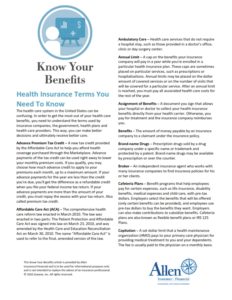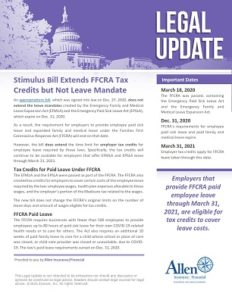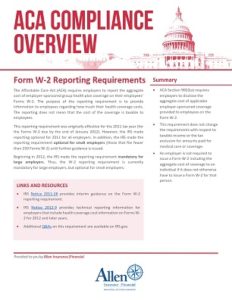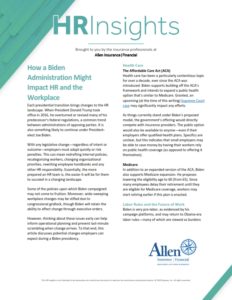Benefit plans are sometimes confusing and employees might be struggling to understand what an employer offers them. This Know Your Benefits flyer lists common terms used in the health insurance industry and explains each in detail. Click for a PDF to download and share with your employees today!
Insurance as a Financial Management Strategy: Things to Think About for the New Year
By Cale Pickford
Originally submitted to Maine Realtor Magazine | Winter 2021
The U.S. is unique in the developed world in that we rely heavily on employers to provide many of the benefits and social safety nets which would otherwise be provided to all citizens on a national basis. The merits of the U.S. system are frequently debated but one clear issue with this system is that independent contractors have to research and purchase their own insurance policies which would otherwise be provided by an employer.
Because of the high cost and difficulty in understanding the products and options available to protect one’s assets and income from risk, many real estate agents, as independent contractors, are at risk − a serious accident or event can have a major impact or their financial well being.
A sound insurance strategy can help protect a family from the financial consequences of loss events. Use the following as an outline for the various insurance products real estate agents should review.
Life Insurance: Your investment advisor may tell you that life insurance is a critical component of a sound financial plan. Anyone who has dependents or a spouse – loved ones who would suffer financially should you die − should seriously consider life insurance because it will allow surviving family members to meet obligations that would have otherwise been funded by your (now missing) income.


Cale Pickford
Disability Income Insurance: In order to maintain your standard of living, it is important to protect your ability to earn an income. Individual disability income insurance helps preserve a portion of your income and provides financial protection if you become disabled for a period of time.
Long-Term Care Insurance: You’re not too young to think about this now. A long-term care insurance policy reimburses a preselected daily amount to cover the cost of skilled nursing care, speech, physical and rehabilitation therapy and services used to assist them with activities of daily living
Health Insurance: Studies suggest that as many as 12% of Americans are without health insurance. Even if you have health insurance or are eligible for Medicare, you should regularly review your plan to make sure that it is the best fit for you and your family’s needs. If you’re on Medicare, talk with an insurance specialist about the best Medicare Supplement Plan for you, to close gaps and reduce out-of-pocket costs.
Homeowners Insurance: Most people who own homes have homeowners insurance. However, a very high percentage of people are underinsured and lack the coverage they will need to make them whole following a loss. Review your policy with an agent, keeping in mind the increasing costs of both construction and to defend and settle bodily injury lawsuits. Also, coverage is very limited for certain types of personal property such as jewelry, firearms, fine arts and so forth, so I recommend insuring items of unique value on a separate valuable articles policy.
Automobile Insurance: Automobile coverage is mandatory in Maine, but just because you have a policy does not mean it will react in the way you expect or need it to. New cars depreciate quickly; make sure you consider gap coverage if you have a loan, or better yet, new car replacement coverage. Learn what coverage you have for towing, roadside assistance, rental cars and glass repair and consider the cost and benefit of having these on your policy. Most importantly, make certain that you have high liability limits and that your vehicle is rated for work use as opposed to pleasure or commuting. It does not matter what coverage you have if a claim is denied for being improperly rated.
An Umbrella Policy: This is perhaps the best value in the insurance industry. Umbrella policies provide protection, in increments of $1 million, for bodily injury and property damage claims which exhaust the limits of your auto, home or watercraft policies. Properly structured, an umbrella policy can greatly reduce the likelihood that a personal lawsuit will devastate your net worth.
Buying a product you hope you never need to use is never a fun way to spend money. Insurance is not the only way to reduce risk: Making smart decisions and being careful go a long way. Still, a properly constructed insurance program is a critical component of a sound financial strategy. Planning for the worst, and hoping for the best, is a good approach in an uncertain world.
Tips to save on your homeowner’s insurance policy
Rightfully so, we focus a lot on ways to make sure your homeowners policy offers proper protection− but cost matters too! Here are some ways to make sure you are getting the best deal in the marketplace:
- Review deductibles: Most insurers structure their rates to reward deductibles of $1,000 or higher. If you have a $500 deductible, you’re likely leaving savings on the table.
- Account credits: Insurance companies are looking for “spread of risk” − that is, insuring multiple policies for the same client. If you have separate insurers for your home and auto look to combine for additional discounts.
- Loss Control Devices: Insurance companies will reward customers who install systems that reduce the likelihood of claims. Central station fire, burglar and low temperature alarms will reduce your premium. Insurers may also offer discounts for automatic generators and automatic water shut-off valves.
- Shopping Around: On a national level, insurance companies have been hit with unprecedented catastrophic losses but Maine has thankfully been spared the worst of these natural disasters. If your renewal premiums have increased significantly, your insurer may be penalizing you for poor performance in other regions. Look for a regional insurer or a national company who has rates in Maine that are more in-line with the risk.
- Coverage Inflation: Insurers increase the amount of coverage on your policy each year. The intent is to keep pace with the increased cost of construction but often those increases compound and the coverage limit gets ahead of the replacement cost of your home. Review the limits of coverage to make sure you are not under-insured or over-insured. My top tip is to find a policy that will offer extended replacement cost of either 125% or 150% of the policy limit, or even unlimited or guaranteed replacement cost coverage. This endorsement will prevent you from being underinsured at the time of a loss.
Everyone Who Uses a Computer Needs Cyber Coverage


By Chris Richmond
Originally Submitted to WorkBoat Magazine
A recent policy review with a client found an interesting update. The client, who distributes seafood, had reduced gross revenues. This was not surprising , given the downturn in the economy. What was surprising was a sharp increase in retail sales. Further discussion revealed that they had a growing online store with direct sales to consumers. They were in need of a cyber policy.
Whether or not you sell goods online, you really should consider a cyber policy. On daily basis, headlines in publications for every industry outline hacks, phishing schemes and other cyber crimes.
There are two important types of cyber liability to know about: First party and third party.
A first party cyber liability occurs when your own data is stolen. This can include your own employees’ personal information or information about your customers. A cyber liability policy will provide credit monitoring services to assist the affected individuals which could help minimize the risk of identity theft. Included in the category of first party cyber liability are:
• Funds Transfer Fraud. Funds Transfer Fraud is an intentional, unauthorized instruction transmitted via email to a financial institution to transfer funds. If your computer system is compromised, a hacker can have access to your banking information and initiate fraudulent electronic wire transfers.
• Lost Business Income. Lost business income due to cyber theft, (a hack or data breach), is not covered unless cyber coverage is in place. Your regular business insurance policy covers you for things like fire, theft and wind, but not anything cyber-related.
Third party liability coverage can provide protection for damage caused by your business to third parties due to a hack. This could be confidential client information that you store in your system. Coverage included in this category are:
• Breach of Privacy: A client’s personally identifiable information has been accessed by an unauthorized party.
• Misuse of Personal Data: Personal data is stolen or misused and they suffer financial damages.
• Transmission of Malicious Content: Failure to stop the transmission of virus, malware or other malicious content.
Many liability policies come with limited cyber coverage but also they leave gaps in coverage. A stand alone cyber policy can cover these gaps and provide the insurance that a business needs today.
Stimulus Bill Extends FFCRA Tax Credits but Not Leave Mandate
An appropriations bill, which was signed into law on Dec. 27, 2020, does not extend the employee leave mandates created by the Families First Coronavirus Response Act, which expire on Dec. 31, 2020. However, the bill extends tax credits for employers who offer the leave through March 31, 2021.
While employers are no longer required to offer the extensive medical leave benefits for COVID-related absences defined under the original FFCRA, the stimulus will provide credits for employers if they decide to extend this offer to them through March 31, 2021. You can read the full bulletin here: Stimulus Bill Extends FFCRA Tax Credits but Not Leave Mandate
Affordable Care Act Compliance Notes – Jan. 6, 2021
The ACA requires employers to report the cost of group health plan coverage on employees’ Forms W-2. This ACA Overview explains the W-2 reporting requirement, including its application to small and large employers. Affordable Care Act Compliance Notes – 6 Jan 2021
Last-Minute Charitable Giving Opportunities
December is the “giving season,” when many people consider using their wealth to help others. Because of the urgent need for generosity presented by the COVID-19 pandemic, you may be looking for ways to stretch your charitable donations. As always, the use of tax-efficient giving strategies can help them go further.
This year, it’s also important to be aware of the tax incentives for philanthropy included in the Coronavirus Aid, Relief, and Economic Security (CARES) Act. The summary below explains how you can maximize these tax-efficient giving incentives during the final weeks of 2020. Two common vehicles for charitable planning—now and in the future—are also covered.
CARES Act Tax Incentives
These incentives, which are set to expire on December 31, 2020, apply only to cash gifts to public charities made by individuals or corporations. Regarding your 2020 tax return, here’s what you need to know:
Are you taking the standard deduction? If you’re not itemizing, you can take an “above-the-line” deduction of up to $300 for cash gifts to charities. The amount you claim will reduce your adjusted gross income (AGI). What about married couples filing jointly? As of this writing, your deduction also seems to be limited to $300, according to IRS draft instructions.
Are you itemizing deductions? Typically, annual charitable deductions are capped at a percentage of a taxpayer’s AGI. For individuals, this cap has been set at 60 percent since 2017. Under the CARES Act, however, you may deduct up to 100 percent of your AGI for gifts of cash to a public charity in 2020. This rule excludes gifts to a donor-advised fund (DAF). For corporations, the AGI cap for cash gifts, previously set at 10 percent, has been raised to 25 percent for the year.
- For both individuals and corporations, any unused deduction under this cap may be carried forward for five years, which can lead to the planning opportunities discussed below. The cap for gifts of appreciated assets has not changed.
Planning Opportunities
If you wish to fund large charitable gifts this year, the 100 percent AGI cap offers huge advantages. Here are several ways this incentive could help you manage high-income events:
- Stock options and lump-sum payouts. If you’ve exercised nonqualified stock options from your employer out of concern for market volatility or received a large lump-sum severance package as a result of a layoff, charitable gifts can help offset the tax burden.
- Roth conversions. If you’d like to make a large Roth conversion this year, you could also make a large charitable gift to offset the tax liability of the conversion. This strategy is especially beneficial because traditional IRAs have become a less attractive way to leave money to heirs since the 2019 passage of the SECURE Act, which requires most IRA beneficiaries to empty their inherited IRA within 10 years.
- Business sale. Let’s say you have an expected AGI of $1 million this year due to a business sale. You could make a charitable contribution that would completely offset the year’s income.
- Combining gifts. Although the CARES Act incentive applies only to cash gifts, the IRS does permit taxpayers to combine different types of gifts. For instance, you could maximize your 30 percent AGI cap for gifts of appreciated assets. The 100 percent AGI cap would be reduced by that amount, but you would still be able to deduct another 70 percent of your AGI by making cash gifts.
Qualified Charitable Distributions (QCDs)
A QCD is a direct transfer of funds from an IRA, payable to a qualified charity. Although the CARES Act allows IRA owners to skip required minimum distributions (RMDs) in 2020, the rules for QCDs have not changed. If you own an IRA (including an inherited IRA) and are 70½ or older, you can make tax-free distributions of up to $100,000 payable to public charities (excluding DAFs).
Here are some ways a QCD could help control your income:
- If you decide to take an RMD this year (or must do so in the future), a QCD could be used to satisfy the distribution. This strategy would remove the tax burden associated with taking the distribution as ordinary income.
- A QCD is not reportable as part of your AGI, which limits its impact on the taxation of social security benefits.
- In future years, a QCD could also limit the impact of income on Medicare premiums, which are based on your AGI from two years prior.
Charitable Remainder Trusts (CRTs)
A CRT can help you (or your beneficiary) spread the tax liability on the sale of appreciated assets over many years. This may result in paying a lower overall effective tax rate. Let’s look at how this works:
- A CRT pays an income stream to a noncharitable beneficiary (or beneficiaries) for a term of years or for life. At the end of the income term, the remaining assets in the trust are distributed to a charity.
- When you move assets into a CRT, you receive a charitable contribution deduction based on the present value of the remainder interest set to pass to the charity at the end of the income distribution term.
- If you contribute appreciated assets (e.g., investment assets, closely held business interests, real estate, or collectibles), those assets can be sold without creating a tax liability to the trust itself.
As you can see, the primary benefit of a CRT is that the trust is exempt from taxes. But that does not mean taxes are entirely avoided for beneficiaries. In fact, the distributions to the income beneficiaries are taxable based on four buckets of income: ordinary income, capital gains, tax-free income, and return of principal. Each year, when the CRT makes its income distribution, it first pulls the funds available from accumulated ordinary income, such as interest and dividends, before distributing other types of income. The beneficiaries would be subject to the taxation rules in place for these types of income.
Need Additional Information?
If you’re interested in exploring these options, please contact me. We’ll talk through how these giving strategies can help you meet today’s urgent need for generosity—and further your visions for doing good.
This material has been provided for general informational purposes only and does not constitute either tax or legal advice. Although we go to great lengths to make sure our information is accurate and useful, we recommend you consult a tax preparer, professional tax advisor, or lawyer.
Who Owns the Ship or the Shipyard? The Importance of a Named Insured
By Chris Richmond
Originally Submitted to WorkBoat Magazine / December 2020


This is about when what seems like a small thing can be a very big thing: Who actually owns the yard, building, ship, truck, tool box or other thing that needs insurance?
We’re talking about something called “insurable interest.” In basic terms, this means the named owner. The real owner is identified as the named insured on an insurance policy. We have seen times when there is an owner in the name of one company but another company (an operations company) actually runs the business.
Very often, the owner of both entities is one and the same. Also very often, that same business owner doesn’t think to identify all of the entities he or she has set up. This will be a serious problem when a claim arises. If the actual legal owner of the property is other than what’s shown on an insurance policy, the policy may not respond because there is no “insurable interest” for the person or entity on the policy. In cases like these, it is most likely the claim will be denied.
In other words, if a company or entity is not named on an insurance policy, it is highly likely there is no coverage.
There was a claim at a local yard where the named insured on the insurance policy was the operating company but not the actual owner of the property. The bank holding the mortgage had accepted proof of insurance that showed the wrong name as the property owner.
There was a devastating fire. When the insurance company’s claims adjuster arrived, he asked who the owner was. When the company owner named the actual company that owned the property, the claims adjuster explained that he didn’t see that entity named anywhere on the insurance policy. Technically, both the owner and the bank were out of luck. After some very heavy negotiations, which included pointing out that the owners of both entities were one and the same, the insurer relented and agreed to pay the claim. This case is an exception to the rule.
When doing an insurance review, the first topic we discuss is the named insured – and we ask if there are any other entities operating that are not listed. As always, the time to have this discussion is before there is a claim as afterwards it is often too late.
The same goes for vessels. Many vessel owners have each vessel in a separate company. Send the vessel’s certificate of documentation to your insurance agent to make sure the actual owner of the vessel is listed correctly on the insurance policy.
How a Biden Administration Might Impact HR and the Workplace
While we don’t have a Magic 8 ball, with a new Executive Administration, all signs point to changes to how you approach your human resources. Our seasoned prognosticators have some insight for you.
Each presidential transition brings changes to the HR landscape. And the more prepared an HR team is, the easier it will be for them to succeed amid these changes. To that end, this article discusses potential changes employers can expect during a Biden presidency.
To read more, click the image at right to view the article (PDF) in a new window.
One Way to Make the Most of your Homeowners Insurance
Homeowners insurance helps you project the things that means so much to you. To be certain that your valued possessions are fully covered against fire, theft and other perils, you should take some extra steps.
Many smart homeowners install security devices, including deadbolt locks, fire extinguishers and burglar alarm systems.
These precautions reduce the chance and severity of a loss. However, there is no guarantee. There is another important step to take – one that is often overlooked.
Create an inventory of the things in your home.
This detailed record of your home furnishings, personal possessions and valuable items, in writing and in pictures, is an important complement to your homeowners insurance.
Having this information will make it easier for you to file a complete and prompt claim, supported by accurate documentation. This will help determine the replacement cost of your lost or damaged possession so your claim can be settled more quickly.
We truly home you never need to access your home inventory. But if you do need it, the investment of time to complete the inventory will have been well worth it.
Contact your Allen Insurance personal insurance account executive for more information. We can provide you with an inventory to complete, guidelines for the kinds of photos to take and a place to store it all.


Your Personal Insurance Team
Do You Use 123456 as Your Password?
QUESTION: What were the top passwords leaked during 2020 data breaches?
We recently came across a new report looking at 275,699,516 passwords leaked during 2020 data breaches – it found that the most common passwords are incredibly easy to guess – and it could take less than a second or two for attackers to break into accounts using these credentials. Only 44% of those recorded were considered “unique.”
If you cyber defenses have failed – or you have been breached by a hacker – cyber insurance can help you recover. Ask a member of the Allen Insurance and Financial business insurance team for more information about cyber coverage. Anyone who does business on the Internet really shouldn’t be without it.
ANSWER: The most popular passwords from those 2020 data breaches included “123456,” “123456789,” “password,” and “12345678.” Read more about the report.
- « Previous Page
- 1
- …
- 26
- 27
- 28
- 29
- 30
- …
- 89
- Next Page »







